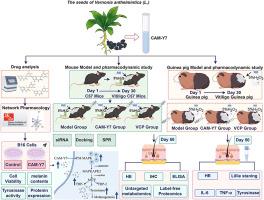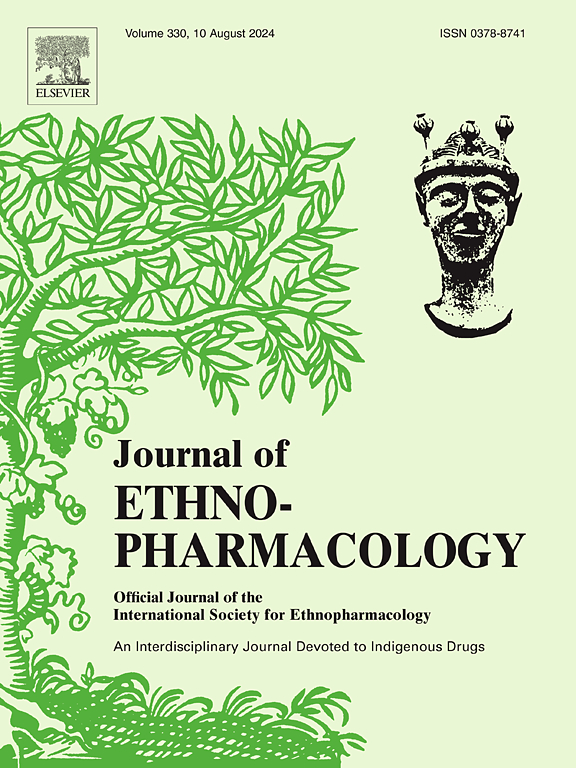驱虫Vernonia anthelmintica (L.)的作用及机制研究Willd。基于多组学和网络药理学的种子提取物对黑色素形成和白癜风的治疗作用。
IF 5.4
2区 医学
Q1 CHEMISTRY, MEDICINAL
引用次数: 0
摘要
民族药理学相关性:白癜风是一种以丧失功能性黑素细胞为特征的色素沉着障碍,导致皮肤和/或头发色素沉着。驱虫虫(Vernonia anthelmintica)在中亚,野生种子提取物传统上用于治疗色素沉着症。但其治疗白癜风的药理机制尚不清楚。研究目的:在先前的研究中,我们从虫体Vernonia anthelmintica (L.)中分离出编码为CAM-Y7的提取物。Willd种子。本研究旨在了解CAM-Y7引发色素沉着的分子基础。材料和方法:首先,我们采用HPLC-MS对CAM-Y7中的成分进行检测和测定。通过网络药理学分析cam - y7 -白癜风可能的共同靶点。我们探讨了CAM-Y7对小鼠和过氧化氢诱导的白癜风模型中黑色素细胞和黑色素生成的影响。利用组织代谢组学和蛋白质组学发现白癜风小鼠的不同代谢物和蛋白质。通过验证性实验,发现了潜在的治疗靶点和分子机制。结果:在CAM-Y7中鉴定出20个化合物,包括咖啡酰奎宁酸、倍半萜类和类黄酮。网络药理学表明CAM-Y7通过黑色素形成、mitf - m调控的黑素细胞发育和酪氨酸代谢作用于白癜风。口服CAM-Y7可使C57BL/6小鼠和豚鼠背部皮肤和毛发逐渐变暗。Lillie染色和苏木精-伊红染色进一步证实CAM-Y7可诱导动物表皮和毛囊的黑色素生成。多组学研究表明,酪氨酸酶和MAPK通路在CAM-Y7治疗白癜风中起重要作用。验证性实验还表明,CAM-Y7通过上调mitf诱导的酪氨酸酶在黑素细胞中的P38/MAPK-MAPKAPK2信号轴的表达,从而促进黑素形成。最后,分子对接和SPR技术表明,Vernodalin是CAM-Y7的潜在活性化合物。结论:驱虫Vernonia anthelmintica (L.)野生种子提取物可能通过激活P38/MAPK-MAPKAPK2信号轴来促进,酪氨酸酶在CAM-Y7诱导的黑素形成中起着至关重要的作用。本文章由计算机程序翻译,如有差异,请以英文原文为准。

Investigating the effects and mechanisms of Vernonia anthelmintica (L.) willd., seed extracts on melanogenesis and vitiligo treatment based on multi-omics and network pharmacology
Ethnopharmacological relevance
Vitiligo is a depigmentation disorder characterized by the loss of functional melanocytes, leading to skin and/or hair depigmentation. Vernonia anthelmintica (L.) Willd seed extracts have been traditionally used to treat pigmentation disorders in Central Asia. However, its pharmacological mechanism for vitiligo is still unknown.
Aims of the study
In a previous study, we isolated the Extracts (encoded as CAM-Y7) from the Vernonia anthelmintica (L.) Willd seed. This research aims to understand the molecular basis of hyperpigmentation triggered by CAM-Y7.
Materials and methods
At first, we employed HPLC-MS to examine and measure the components in the CAM-Y7. The possible CAM-Y7–Vitiligo common targets were analyzed by network pharmacology. We explored the effects of CAM-Y7 on melanin production in melanocytes and vitiligo models induced by hydroquinone in mice and hydrogen peroxide in guinea pigs. Tissue-based metabolomics and proteomics were utilized to find varying metabolites and proteins in vitiligo mice. Through confirmatory experiments, potential therapeutic targets and molecular mechanisms were discovered.
Results
Twenty compounds were identified in CAM-Y7, including caffeoylquinic acids, sesquiterpenoids, and flavonoids. Network pharmacology indicated that CAM-Y7 acts on vitiligo through melanogenesis, MITF-M-regulated melanocyte development, and Tyrosine metabolism. Oral administration of CAM-Y7 progressively darkened the dorsal skin and hair of C57BL/6 mice and guinea pigs. Both Lillie staining and hematoxylin-eosin staining further demonstrated that CAM-Y7 induced melanogenesis in the epidermis and hair follicles of the animals. Multi-omics studies have shown that the Tyrosinase and MAPK pathways are important in CAM-Y7 treatment for vitiligo. Confirmatory experiments also indicated that CAM-Y7 promotes melanogenesis by upregulating MITF-induced Tyrosinase expression via the P38/MAPK-MAPKAPK2 signaling axis in melanocytes. Finally, molecular docking and SPR techniques suggested that Vernodalin is a potentially active compound in CAM-Y7.
Conclusion
The regulation of melanogenesis by Vernonia anthelmintica (L.) Willd seed extracts might be facilitated through the activation of the P38/MAPK-MAPKAPK2 signaling axis, with Tyrosinase playing a crucial role in the melanogenesis induced by CAM-Y7.
求助全文
通过发布文献求助,成功后即可免费获取论文全文。
去求助
来源期刊

Journal of ethnopharmacology
医学-全科医学与补充医学
CiteScore
10.30
自引率
5.60%
发文量
967
审稿时长
77 days
期刊介绍:
The Journal of Ethnopharmacology is dedicated to the exchange of information and understandings about people''s use of plants, fungi, animals, microorganisms and minerals and their biological and pharmacological effects based on the principles established through international conventions. Early people confronted with illness and disease, discovered a wealth of useful therapeutic agents in the plant and animal kingdoms. The empirical knowledge of these medicinal substances and their toxic potential was passed on by oral tradition and sometimes recorded in herbals and other texts on materia medica. Many valuable drugs of today (e.g., atropine, ephedrine, tubocurarine, digoxin, reserpine) came into use through the study of indigenous remedies. Chemists continue to use plant-derived drugs (e.g., morphine, taxol, physostigmine, quinidine, emetine) as prototypes in their attempts to develop more effective and less toxic medicinals.
 求助内容:
求助内容: 应助结果提醒方式:
应助结果提醒方式:


